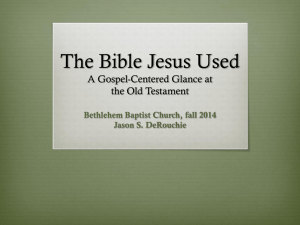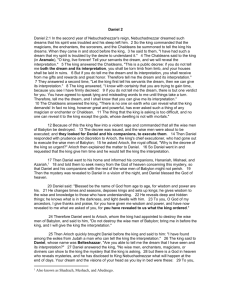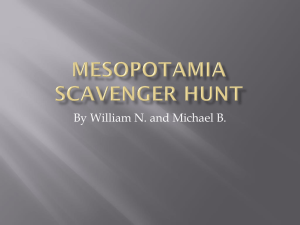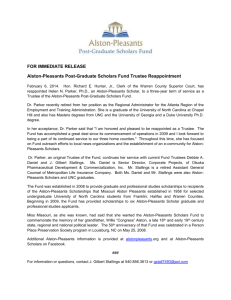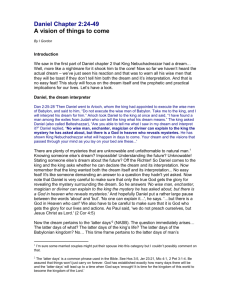Daniel II
advertisement
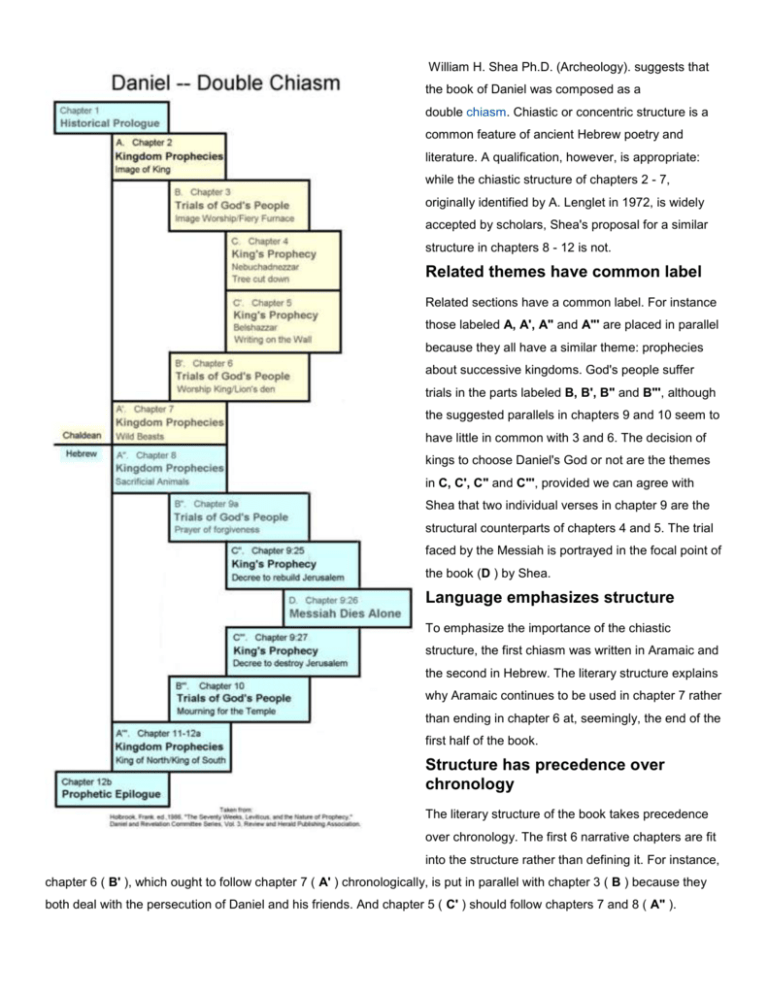
William H. Shea Ph.D. (Archeology). suggests that the book of Daniel was composed as a double chiasm. Chiastic or concentric structure is a common feature of ancient Hebrew poetry and literature. A qualification, however, is appropriate: while the chiastic structure of chapters 2 - 7, originally identified by A. Lenglet in 1972, is widely accepted by scholars, Shea's proposal for a similar structure in chapters 8 - 12 is not. Related themes have common label Related sections have a common label. For instance those labeled A, A', A" and A"' are placed in parallel because they all have a similar theme: prophecies about successive kingdoms. God's people suffer trials in the parts labeled B, B', B" and B"', although the suggested parallels in chapters 9 and 10 seem to have little in common with 3 and 6. The decision of kings to choose Daniel's God or not are the themes in C, C', C" and C"', provided we can agree with Shea that two individual verses in chapter 9 are the structural counterparts of chapters 4 and 5. The trial faced by the Messiah is portrayed in the focal point of the book (D ) by Shea. Language emphasizes structure To emphasize the importance of the chiastic structure, the first chiasm was written in Aramaic and the second in Hebrew. The literary structure explains why Aramaic continues to be used in chapter 7 rather than ending in chapter 6 at, seemingly, the end of the first half of the book. Structure has precedence over chronology The literary structure of the book takes precedence over chronology. The first 6 narrative chapters are fit into the structure rather than defining it. For instance, chapter 6 ( B' ), which ought to follow chapter 7 ( A' ) chronologically, is put in parallel with chapter 3 ( B ) because they both deal with the persecution of Daniel and his friends. And chapter 5 ( C' ) should follow chapters 7 and 8 ( A" ). Instead, it is put in parallel with chapter 4 ( C ). In both divine judgements are pronounced against arrogant Babylonian kings. Grouping Emphasizes Prophecies This chiastic grouping of chapters having the same theme has important implications when it comes to the chapters containing prophecies ( A, A', A", A'" ). Not only are they parallel because they contain prophecies, but the prophecies themselves are parallel to each other. This parallelism between the prophecies has been recognized for millennia. This does not mean, however, that Christian commentators have identified the same kingdoms in each chapter. While chapters 2 and 7 have generally - though not exclusively[14] - been interpreted as extending to Roman times, chapter 8, for example, has traditionally been applied to the time of Antiochus Epiphanes. [15] Daniel II – Dream On Identification of the four kingdoms Over the centuries, scholars have proposed two alternative views regarding the identification of the four kingdoms in Daniel 2. One view has traditionally been more prevalent among Christian scholars, at least as far back as Hippolytus (including Augustine, Thomas Aquinas, and Martin Luther, E. J. Young etc 1. The gold head - Babylon 2. The silver breast and arms - Medo-Persia 3. The brass belly and thighs - Greece 4. The iron legs - Rome 5. The feet partly of iron and partly of molded clay - The divided Roman Empire Another view has been more popular among Jewish scholars, at least as far back as Flavius Josephus, and has support from 20th century Biblical scholars such as John J. Collins[4] as well as conservative Christian scholars such as H. H. Rowley, Gurney, Lucas, and Walton. The proposed sequence is: 1. The gold head - Babylon 2. The silver breast and arms - Media 3. The copper belly and thighs - Persia 4. The iron legs - Greece 5. The feet partly of iron and partly of molded clay - The Seleucids and the Ptolemies Daniel 2:43("they shall mingle themselves with the seed of men: but they shall not cleave one to another") in the second view refers to the unsuccessful marriage alliances between the Seleucids and Ptolemies.(Daniel 11:6, 11:17 According to scholars who hold to this view, only these two successors to the Greek Kingdom were of interest to the author and his Jewish readers since these 2 dynasties had direct relation to Jewish affairs. They often fought over the ownership of Judea and the control of Jews in the 2nd century BC(Daniel 11:2-35). A modern interpretation of the 4 kingdoms (Babylon, Media, Persia, Greece) is associated with the theory that the book of Daniel is a pseudepigraph dated to the mid-2nd century BC, concerned primarily with the Maccabean era and the reign of the Seleucid king Antiochus Epiphanes.[11] The vision therefore terminates in the Hellenist era, and the "kingdom" represented by the stone could then refer to the Hasmonean dynasty set up by the Maccabees, after their defeat of the Seleucid forces. However, many Christian scholars do not accept this interpretation, largely because Jesus is said in Matthew 24 to have quoted Daniel as a prophet who foretold future events. Some scholars believe that Jesus placed the fulfillment of Daniel's prophecy at the fall of Jerusalem in AD 70,; others think he was describing the "end of the age" (Matt. 24:3), immediately preceding Judgement Day.[16] Therefore, their identification of the metals in the statue with empires tends to differ somewhat from the above-mentioned view of the scholars. Instead, the vision is considered to be about the development of Babylon and its successors, from the time of Nebuchadnezzar all the way to the future day when God's eternal Kingdom will be established. In Christian interpretations, the Kingdom of God (represented by the stone that destroys the statue) may be considered in a spiritual sense, as the kingdom set up by Jesus through his death and resurrection during the time of the Roman empire; or alternatively as the literal and physical kingdom that Jesus will set up at his second coming, in which case the feet and toes of part iron and part clay must represent the nations which take the place of the Roman empire until the end of time. Mormon interpretation The story in Daniel 2 has significant meaning to members of The Church of Jesus Christ of Latter-day Saints, who believe that the true church was restored to the earth in the "latter days" through a modern prophet, Joseph Smith, in 1830. Spencer Kimball explained in 1976, "The Church of Jesus Christ of Latter-day Saints was restored in 1830. ...This is the kingdom, set up by the God of heaven, that would never be destroyed nor superseded, and the stone cut out of the mountain without hands that would become a great mountain and would fill the whole earth." Kimball agreed with the view of most Christians that the third kingdom represented that of Alexander the Great, the fourth represented the Roman Empire, and the feet of iron and clay represented a group of European nations, which were the great political powers at the time the Latter Day Saint movement was founded.[18][19] Jehovah's Witnesses interpretation In the Jehovah's Witnesses' interpretation of Nebuchadnezzar's dream,[20] the statue is said to represent the following kingdoms: 1. The gold head - Babylon 2. The silver breast and arms - Medo-Persia 3. The copper belly and thighs - Greece 4. The iron legs - Rome and later, its political descendant, the Anglo-American World Power 5. The feet partly of iron and partly of molded clay - All earthly governments during the time of end that are unitedly,opposed to the Messianic Kingdom established in the heavens. This is the final state of human rule. The Anglo-American power is seen as the last dominant world power, emerging from a part of the Roman Empire (the iron legs) first as the British Empire, and then with the formation of the United States of America, to develop into the present-day special relationship between the United States and the United Kingdom. However the prophecy comments on the general state of human rule in addition to the last dominant human world power. This state is represented by the iron-and-clay, feet and toes of the statue. The iron and clay represent three characteristics of human rule, in general, during the time of the end (Vss 41-43): 1) These are incompatible materials, in that they do not mix. This represents the traditional authoritarian rule uneasy coexisting with democratic rule. 2) The "lack of sticking together" describes the political fragmentation throughout human rule in the last days. 3) The focus of the clay as "the offspring of mankind" represents the common people having a say in how they are ruled during this time. The "kingdom, which shall never be destroyed: and ... not be left to other people, but it shall break in pieces and consume all these kingdoms, and it shall stand forever", in verse 44 of the prophecy, is said by Witnesses to be the heavenly kingdom established by God, with Jesus as appointed King, which will ultimately bring to an end human ruler ship. This Kingdom will rule the earth. It is a special government sponsored by God's Universal Sovereignty (the mountain in vs 35) to restore humans to perfection and restore the physical earth to its original and intended state of paradise. Jehovah's Witnesses also believe that the sequence of world powers in Nebuchadnezzar's dream parallels that given in the vision in the Book of Revelation Chapter 17, verse 10 which speaks of "seven kings: five have fallen, one is, the other has not yet arrived". (Egypt, Assyria, Babylon, Medo-Persia and Greece having "fallen" by the time Revelation was written; Rome was the world power at the time - "one is" - while the British Empire and subsequent emergence of the United States and their later alliance was then yet to come, hence "the other has not yet arrived".) Seventh-day Adventist interpretation The Seventh-day Adventist interpretation of the statue is inherited from the Millerite movement. Chapter Parallel sequence of prophetic elements as understood by Historicists[21][22] Past Chest & 2 Head arms Daniel 2 Gold Silver (Babylon) (Media-Persia) Belly and thighs Bronze (Greece) Present 2 Legs Iron Pagan & Papal Rome 2 Feet with toes Clay & Iron Global religiopolitical Government Future Rock God's unending kingdom left to no other people As the iron and clay are materials that simply cannot be used together to form a durable structure, Adventist scholars interpret this as the many short-lived successes throughout European history by various people to form a large empire or to form Europe into one large entity, such as the Holy Roman Empire, Napoleonic France, Nazi Germany, The European Union. Some propose a future religo-political power developed and enforced by the global superpower— the United States of America.


